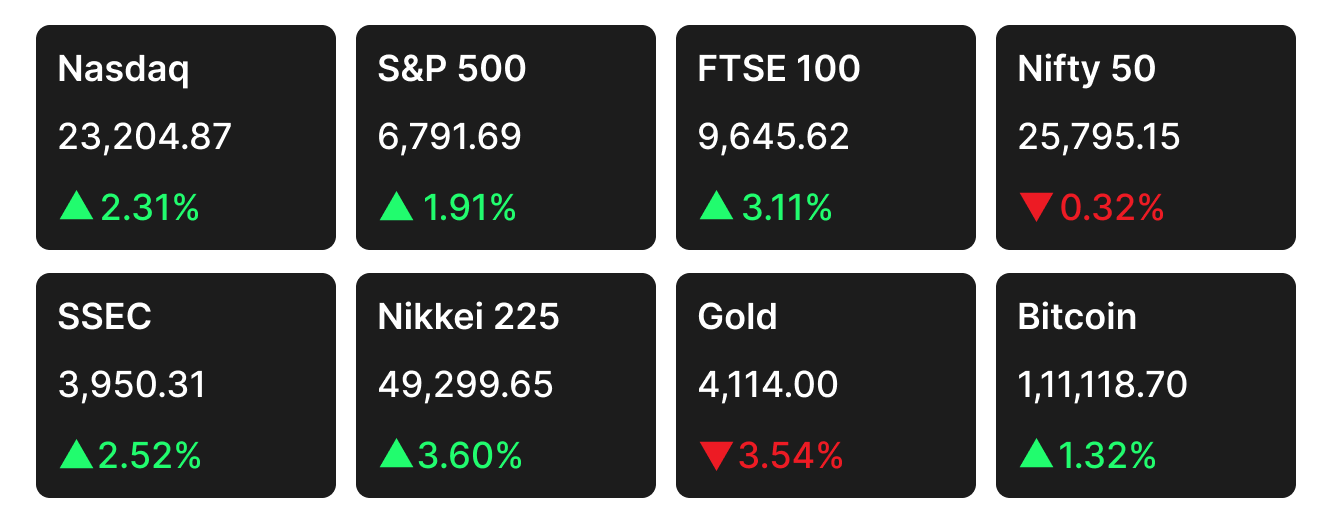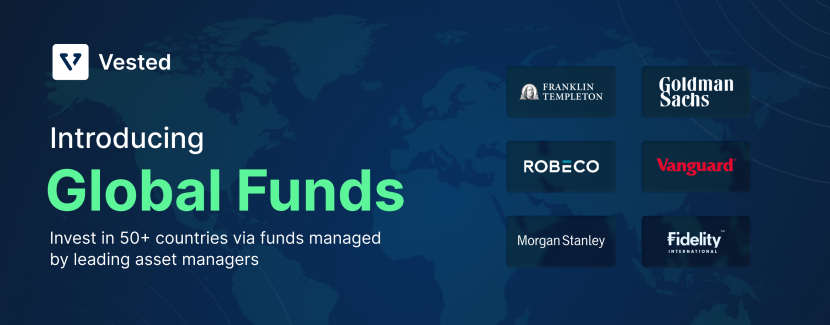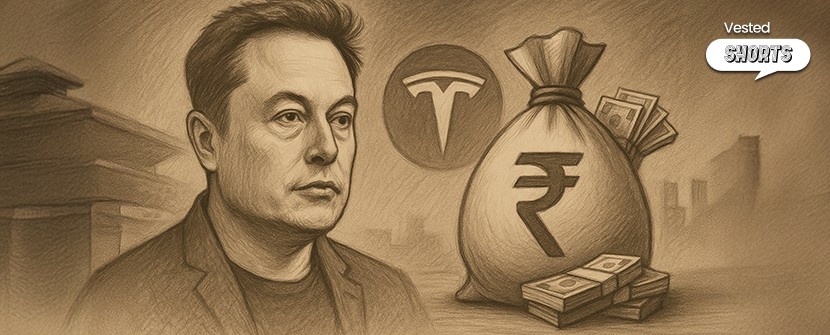Welcome to Vested Shorts,
The World in a Week: How Major Markets Moved
United States | Stocks gained as trade jitters eased. The S&P 500 rose 1.9% and the Nasdaq 2.3%, led by tech and energy. Inflation came in at 3.0%, slightly below forecasts, while business activity picked up with PMIs (purchasing managers index) at 54.8.
Europe | The STOXX 600 added 1.7% and the FTSE 100 climbed 3.1% on upbeat retail data. UK inflation stayed at 3.8%, and Eurozone PMIs hit a 17-month high, showing improving demand.
Asia | Japan’s Nikkei jumped 3.6% on stimulus hopes under new PM Sanae Takaichi, while China’s SSEC rose 3.2% as GDP grew 4.8% YoY and factory output beat forecasts.
India | The Nifty 50 slipped 0.3% as investors booked profits. Hindalco (+6%) and Infosys (+5%) led gainers, while HUL (-3%) and Kotak Bank (-2%) lagged.
Commodities | Oil surged 7% after U.S. sanctions on Russian producers, with Brent near $66. Gold fell 3% to $4,100/oz (1 oz = 28.3495 g), cooling after recent record highs.

Stock market closing data for the week of Oct 20 to Oct 24, 2025
Index information: STOXX 600 (tracks 600 large, mid- & small-cap EU firms), DAX (top 40 German blue chips), CAC 40 (leading French stocks), Nikkei 225 (225 top Japanese stocks), CSI 300 & SSEC (mainland China A-shares), and Hang Seng (large-cap Hong Kong-listed firms). For these indices, we track 1-week returns to capture how global sentiment is shifting.
News Summaries
Tesla Returns to Growth, but Profit Slips on Higher Costs
After two quarters of decline, Tesla reported a 12% rise in revenue for the third quarter, reaching $28.1 billion, above analyst estimates. But profits missed expectations as higher expenses and falling prices took a toll, sending the stock down nearly 5% in extended trading.
Net income fell 37% year over year to $1.37 billion, pressured by a 50% jump in R&D spending tied to AI and new projects. The company’s operating costs also surged as it ramped development on future vehicles and robotics. Revenue from regulatory credits plunged 44%, highlighting Tesla’s growing reliance on core sales.
While vehicle deliveries hit a record 497,099 units, growth was uneven. Sales in Europe continued to struggle amid consumer pushback against Elon Musk and rising competition from BYD and Volkswagen. Tesla offered little guidance, choosing instead to highlight progress on its Robotaxi program and plans to begin Cybercab and Semi production in 2026.
A bright spot was Tesla’s energy business, with revenue up 44% to $3.4 billion, now contributing a quarter of total sales. For Musk, the next phase is clear: fewer promises, more production.
Corporate America Delivers Its Strongest Earnings Beat in Four Years
Earnings season is off to a roaring start in the US.
So far, 85% of S&P 500 companies reporting third-quarter results have beaten profit estimates the highest proportion since 2021, according to Bloomberg Intelligence.
While less than one-fifth of the index has announced results, the early data signals that corporate profits remain resilient despite tariffs, policy uncertainty, and slowing economic momentum. Analysts had raised expectations heading into the quarter, making the strong showing even more notable.
The earnings strength is broad-based. Citigroup and Morgan Stanley beat forecasts among banks, General Motors raised guidance on robust truck demand, and Coca-Cola surprised investors with strong sales despite higher prices.
Strategists say the results are helping offset market anxiety tied to trade tensions and the government shutdown. JPMorgan’s Dubravko Lakos-Bujas expects S&P 500 earnings to rise about 12% this quarter, outpacing consensus forecasts of 7.7%.
For investors, it’s a reassuring reminder: the US earnings engine, powered by AI investment, consumer demand, and corporate adaptability is still running strong, even as the market rally cools.
Wall Street Banks Deepen Ties with Private Credit
A new Moody’s Ratings report shows that US banks have lent nearly $300 billion to private credit providers as of June 2025 even as concerns mount about underwriting quality and leverage in the sector.
The exposure is led by Wells Fargo, with about $60 billion in business credit to direct lenders, private credit funds, and CLOs. In total, lending to non-depository financial institutions, a category that includes hedge funds, private equity, and pension funds has ballooned to $1.2 trillion, now more than a tenth of all US bank loans.
For banks, backing private lenders offers a way to profit from high-yield opportunities without directly taking on risky borrowers. Yet, the recent collapses of Tricolor Holdings and First Brands Group have raised fresh questions about credit discipline and systemic exposure.
Despite the cautionary tone, private credit’s momentum remains unshaken with US private debt assets have tripled in a decade. As banks finance the lenders rather than compete with them, Wall Street’s new risk frontier is increasingly hiding in plain sight.
Introducing Global Funds on Vested

After enabling lakhs of Indian investors to invest in US stocks and ETFs, Vested is now opening the next frontier with Global Funds.
The new offering gives investors access to 50+ international funds managed by global leaders such as BlackRock, Vanguard, and PIMCO, helping them diversify across regions and asset classes through simple, SEBI-compliant routes.
As part of this launch, Vested is also introducing GIFT City–domiciled funds, starting with the DSP Global Equity Fund, an actively managed portfolio investing in leading global companies across the US, Europe, and Asia.
With INR-based investing, simplified taxes, and no US inheritance tax, Global Funds makes global diversification as seamless as investing in India now on a platform built for global investors by India’s global investing specialist.
From the World of Crypto
Bitcoin May Dip Before a Fresh Record Rally
Bitcoin’s rally may pause before it resumes. According to Standard Chartered’s Geoff Kendrick, the world’s largest cryptocurrency could fall below $100,000 in the coming weeks amid renewed trade tensions between the U.S. and China.
Kendrick said a short-lived “fear-driven selloff” tied to tariff uncertainty is likely, even as his year-end target of $200,000 remains intact. Bitcoin was trading around $108,200, down roughly 12% from its all-time high of $126,000 reached earlier this month.
Historically, October and November have been Bitcoin’s strongest months, averaging double-digit gains. Yet this time, the macro backdrop has shifted with tariffs, interest rates, and geopolitical uncertainty driving short-term volatility.
Interestingly, the traditional safe haven, gold, has started to weaken. A sharp drop in gold prices this week coincided with a Bitcoin rebound, suggesting some investors may be rotating from gold into crypto.
If that pattern holds, Kendrick said, the next leg higher could mark the final time Bitcoin dips below six figures before setting new record highs.
Key Headlines of the Week
Walmart Halts H-1B Hiring After $100K Visa Fee Rule | Walmart has paused offers to candidates needing H-1B visas following the Trump administration’s $100,000 fee. The move affects mainly corporate roles and highlights growing concern that the cost could make US firms avoid global talent.
OnlyFans Pays $25B to Creators Since 2016 | CEO Keily Blair said the platform has paid out $25 billion to creators while keeping 20% in fees. OnlyFans is exploring sale options and expanding beyond adult content into comedy, sports, and cooking.
China ETFs See $391M Outflow on Trade Jitters | Funds tracking Chinese stocks saw $391 million in outflows, led by the CSI 300 ETF, the biggest since April. Renewed US-China trade tension under Trump has left investors cautious ahead of fresh talks.
















